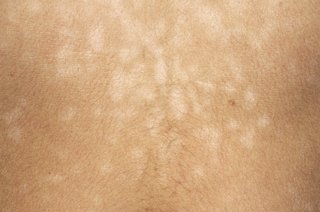How Do You Know Tinea Versicolor Fungus Is Killed
Pityriasis versicolor, sometimes called tinea versicolor, is a common fungal infection that causes small patches of skin to become scaly and discoloured.
Symptoms of pityriasis versicolor
Patches of pare may be darker or lighter than your normal pare colour, or may exist cherry-red, brown or pinkish. They tend to develop gradually and may bring together up to form larger patches over time.

The areas most often affected by pityriasis versicolor include the back, chest, upper artillery, neck and tummy.
Although it may await unpleasant and the patches are sometimes itchy, pityriasis versicolor is harmless.
You may nonetheless want to see a GP, equally it usually only improves with handling. They can ordinarily diagnose pityriasis versicolor by examining your skin.
Why it happens
Pityriasis versicolor is acquired by a type of yeast called Malassezia. This yeast is constitute on the peel of more than 90% of adults, where it normally lives without causing whatsoever issues.
But pityriasis versicolor can develop if this yeast starts to multiply more than usual. It'south not clear exactly why this happens in some people and not in others.
Several factors can increase your risk of developing pityriasis versicolor, including:
- living or staying in a warm, moist surround, including the UK, in the summertime
- sweating excessively (hyperhidrosis)
- creams, dressings or habiliment that do non let your pare to breathe
- being malnourished
- having a weakened immune system
- being a teenager or in your early 20s
Pityriasis versicolor is not related to poor hygiene. The condition cannot be spread from person to person because near people already take the Malassezia yeast on their skin.
How pityriasis versicolor is treated
Pityriasis versicolor tin can be treated with antifungal medicines. These are available every bit shampoos, creams and tablets.
Antifungal shampoos
Antifungal shampoos (such as ketoconazole shampoo) are often the first treatment recommended for pityriasis versicolor.
Some are available to purchase over the counter from pharmacies, or a GP tin can prescribe them.
If you are buying an antifungal shampoo without a prescription, make certain it is suitable for treating pityriasis versicolor. Cheque the leaflet that comes with the shampoo or inquire a pharmacist.
In most cases, these shampoos need to be fabricated into a lather and left on the afflicted areas of skin for five to ten minutes before being rinsed off. This usually needs to be repeated every day for 5 to 7 days.
You may experience some peel dryness or irritation when using these shampoos.
It may exist helpful to dilute the shampoo with water before applying it.
Antifungal creams
If simply small areas of skin are affected, a GP may prescribe an antifungal cream.
These creams usually need to be applied to the affected area of skin one time or twice a mean solar day for several weeks.
Some people feel a burning sensation when they employ these antifungal creams, but this is not mutual.
Antifungal tablets
If a large area of skin is afflicted or other treatments accept not helped, you may be prescribed antifungal tablets.
These usually need to be taken once a day for one to 4 weeks.
Side effects of these tablets are uncommon, although some people experience issues such as rashes, feeling sick and stomach (abdominal) pain while taking them.
Outlook
Overall, antifungal shampoos, creams and tablets are constructive in killing the yeast that causes pityriasis versicolor.
Merely information technology can have several weeks or months for your skin to return to its normal colour. In more persistent cases, treatment may need to exist repeated.
Recurrences
It's common for pityriasis versicolor to come up dorsum later on handling, peculiarly during the summertime or during holidays to warm and boiling countries.
Merely y'all can reduce this likelihood by regularly using the antifungal shampoos mentioned higher up.
For example, using the shampoo in one case a mean solar day for a few days before going on holiday tin can aid forestall pityriasis versicolor recurring.
Equally these shampoos are available to buy from pharmacies, you do not demand to see a GP for a prescription if y'all run out.
If y'all develop pityriasis versicolor again after treatment, you can try treating it yourself with antifungal shampoo, or see a GP for communication and other treatments.
If you accept frequent and severe episodes of pityriasis versicolor, a GP may consider prescribing antifungal tablets to take a few times a month to prevent the status recurring.
They may also refer you to a pare specialist called a dermatologist.
Pityriasis versicolor or vitiligo?
Pityriasis versicolor can sometimes exist confused with vitiligo, as they both cause the skin to get discoloured in patches.
But at that place are ways to tell the difference:
- vitiligo often develops on both sides of your torso at the aforementioned time, whereas pityriasis versicolor may not
- skin affected past vitiligo usually has a normal texture, whereas areas afflicted past pityriasis versicolor are commonly slightly scaly or flaky
- vitiligo is more mutual effectually the mouth, eyes, fingers, wrists, armpits and groin, whereas pityriasis versicolor tends to develop on the dorsum, chest, upper arms, neck and tummy
Observe out more most vitiligo
Page last reviewed: 12 July 2018
Adjacent review due: 12 July 2021
Source: https://www.nhs.uk/conditions/pityriasis-versicolor/
0 Response to "How Do You Know Tinea Versicolor Fungus Is Killed"
Post a Comment